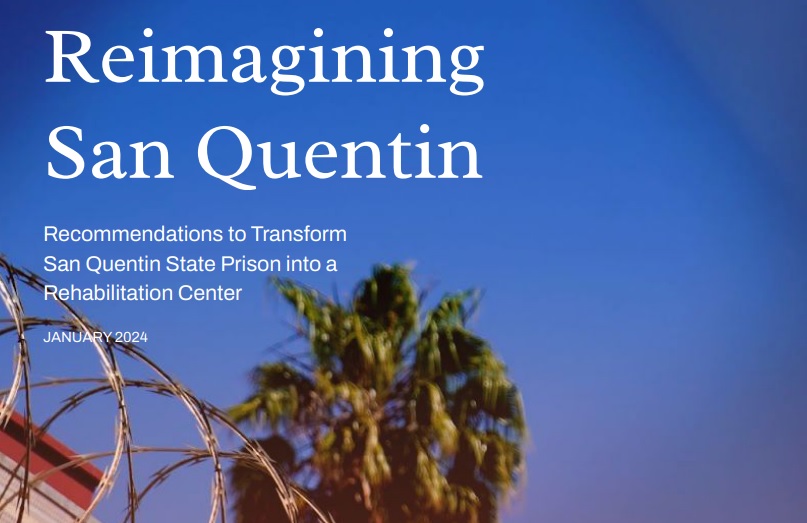SACRAMENTO – CDCR today announced the San Quentin Transformation Advisory Council submitted its independent report aimed at improving public safety in California by reshaping San Quentin into a premier rehabilitation center through a scalable model.
Report offers three dozen independent recommendations
The independent report, which is divided into 11 sections consisting of more than three dozen independent recommendations, calls for:
- expanding rehabilitation and reentry plans
- optimizing education and job training programs
- and evolving correctional officer training to create a more rehabilitative culture.
Among other recommendations, the Advisory Council suggests:
- reducing the size of the incarcerated population to improve programming and outcomes
- improve housing for both the population and facility staff
- invest in reentry beds
- and reduce costs for new construction at San Quentin.
The full report and all recommendations can be viewed here.
The next steps for the report
CDCR, in partnership with the Governor’s Office and stakeholders including the Legislature, will thoroughly review the report and identify feasible next steps related to the Advisory Council’s recommended action items.
“This report touches every aspect of what it will take to transform not only San Quentin from a prison to a rehabilitation center, but over time, also provides the road map for changing the entire correctional system. Culture change requires both a healthier physical environment, and a commitment by all, including the correctional officers and other personnel, and the residents to ensure that people who serve their time have every tool to succeed once they are released,” said Sacramento Mayor Darrell Steinberg, the Governor’s lead advisor for this initiative. “This report represents a signature opportunity to both enhance public safety and human dignity. Thank you to the Governor for the opportunity. Thank you to the advisory council for an inspired report.”
“This report draws on international best practices to offer imaginative, hopeful, uniquely Californian recommendations to reduce harm and improve the dignity and rehabilitative outcomes associated with living or working at San Quentin,” said Advisory Council Co-Chair and Professor of Medicine at the UCSF Center for Vulnerable Populations Dr. Brie Williams. “It has been an honor to serve as Co-Chair on this effort to bring a public health lens to prison reform in California.”
“Governor Newsom is opening the door for California to lead the nation with a recovery-centered justice system that sees each person in its care as an opportunity for healing,” said Advisory Council Co-Chair and Amity Foundation CEO Doug Bond. “Today’s report outlines a clear path for California to cross that threshold by transforming not just San Quentin, but the way we approach justice and rehabilitation in our state.”
“It was a privilege and an honor to work with the San Quentin Advisory Council to develop this report,” said Advisory Council Co-Chair and CDCR Director of Adult Institutions Ron Broomfield. “CDCR’s commitment to the California Model, coupled with the recommendations in this report, will ensure San Quentin staff and residents are afforded the best training, as well as the best working and living conditions which will result in improved public safety.”
“I’d like to thank the San Quentin Advisory Council and its co-chairs for this tremendous undertaking,” said Governor Gavin Newsom. “California is at the forefront of innovation and groundbreaking transformation as we reimagine San Quentin to better serve our state — and improve public safety. San Quentin is becoming a national model to show positive rehabilitation can improve the lives of those who live and work at prisons and make all communities – inside and out of our institutions – safer.”
“This new energy and perspective will help California fine-tune its plan to bring hope and the practical tools needed to make change at San Quentin,” said CDCR Secretary Jeff Macomber. “What we learn now will enable us to take positive, uplifting action system-wide to improve the lives of employees and incarcerated individuals.”
The Advisory Council explained
Governor Newsom formed the Advisory Council in March 2023. The council is a multidisciplinary group that includes experts with many backgrounds and disciplines, who bring broad knowledge and perspective to reimagine San Quentin.
Last spring, Governor Newsom, alongside lawmakers, survivors of crime and victim advocates, and civil rights leaders, announced that San Quentin State Prison — the oldest and most notorious prison in California and home to the largest “death row” in the United States — will be transformed from a maximum-security prison into a one-of-a-kind facility focused on improving public safety through rehabilitation and education. The prison, renamed “San Quentin Rehabilitation Center,” will be transformed in part under the direction of an advisory group composed of state and world-renowned rehabilitation and public safety experts. The historic effort at San Quentin, never pursued at this scale in the United States, will serve as a nationwide evidence-backed model to advance a more effective justice system that builds safer communities.
The California Model
CDCR is driving a once-in-a-generation transformation of California’s prison system. This reimagining is referred to as the California Model: Making safer communities, inside and out. The California Model is a holistic initiative leveraging international, data-backed best practices to improve the well-being of those who live and work at state prisons. For all Californians, the goal is to make communities safer and life better by leveraging data-backed, proven measures to break cycles of crime for the incarcerated population, while improving workplace conditions for institution staff.
For media inquiries, e-mail the Office of Public & Employee Communications.
See more stories about CDCR facilities, training and jobs.
Learn more about the California Model on the CDCR website.
Follow CDCR on YouTube, Facebook, X (formerly Twitter). Listen to the CDCR Unlocked podcast.
